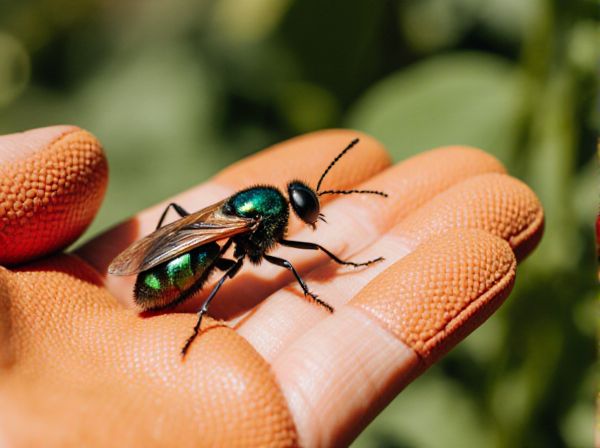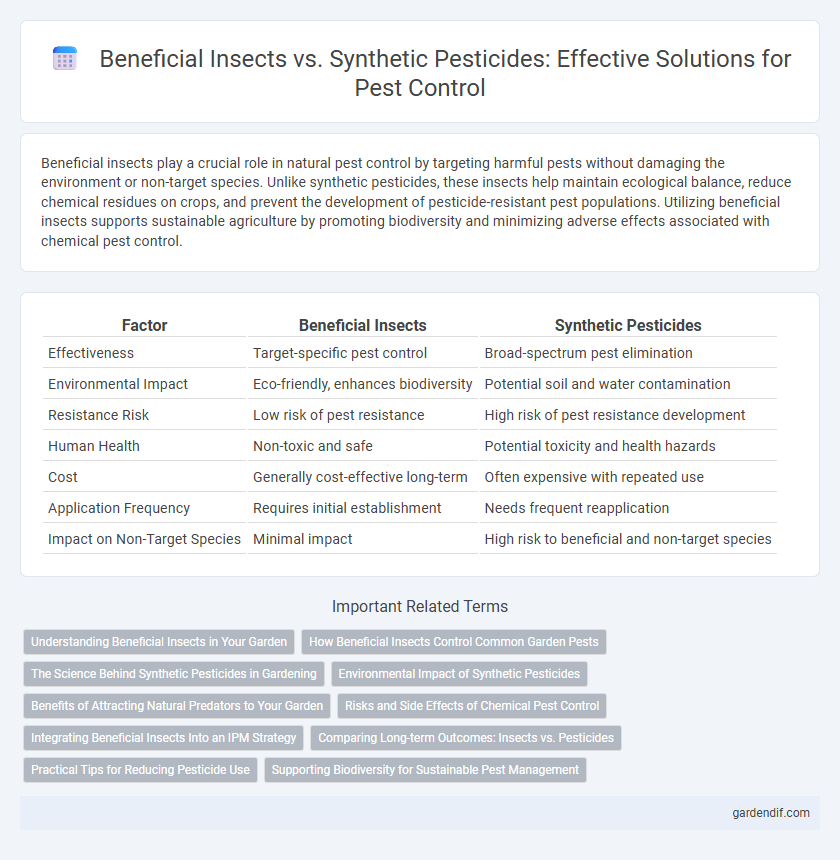
Beneficial insects vs synthetic pesticides Illustration
Beneficial insects play a crucial role in natural pest control by targeting harmful pests without damaging the environment or non-target species. Unlike synthetic pesticides, these insects help maintain ecological balance, reduce chemical residues on crops, and prevent the development of pesticide-resistant pest populations. Utilizing beneficial insects supports sustainable agriculture by promoting biodiversity and minimizing adverse effects associated with chemical pest control.
Table of Comparison
| Factor | Beneficial Insects | Synthetic Pesticides |
|---|---|---|
| Effectiveness | Target-specific pest control | Broad-spectrum pest elimination |
| Environmental Impact | Eco-friendly, enhances biodiversity | Potential soil and water contamination |
| Resistance Risk | Low risk of pest resistance | High risk of pest resistance development |
| Human Health | Non-toxic and safe | Potential toxicity and health hazards |
| Cost | Generally cost-effective long-term | Often expensive with repeated use |
| Application Frequency | Requires initial establishment | Needs frequent reapplication |
| Impact on Non-Target Species | Minimal impact | High risk to beneficial and non-target species |
Understanding Beneficial Insects in Your Garden
Beneficial insects such as ladybugs, lacewings, and parasitic wasps play a crucial role in natural pest control by preying on harmful garden pests like aphids and caterpillars. Unlike synthetic pesticides, these insects help maintain ecological balance without harming pollinators or contaminating soil and water sources. Encouraging beneficial insect populations through habitat creation and reduced chemical use enhances garden health and promotes sustainable pest management.
How Beneficial Insects Control Common Garden Pests
Beneficial insects such as ladybugs, lacewings, and parasitic wasps naturally control common garden pests by preying on aphids, caterpillars, and whiteflies, reducing the need for synthetic pesticides. These predators maintain ecological balance by targeting pest populations without harming plants or pollinators, supporting sustainable gardening practices. Introducing and conserving beneficial insect habitats enhances pest control efficiency, minimizes chemical use, and promotes healthy plant growth.
The Science Behind Synthetic Pesticides in Gardening
Synthetic pesticides in gardening are engineered chemical compounds designed to target specific pests by disrupting their biological processes, such as nervous system function or reproductive capabilities. Unlike beneficial insects that naturally control pest populations through predation and parasitism, synthetic pesticides provide immediate and broad-spectrum pest eradication, but often at the cost of environmental balance and non-target species. Research highlights the importance of understanding pesticide mode of action to minimize resistance development and environmental impact while maximizing pest control efficacy.
Environmental Impact of Synthetic Pesticides
Synthetic pesticides contribute significantly to environmental degradation by contaminating soil, water, and non-target organisms, including beneficial insects essential for natural pest control. Their persistent chemical residues disrupt ecosystems, reduce biodiversity, and have been linked to pollinator decline and resistance development in pest populations. In contrast, beneficial insects promote sustainable agriculture by naturally regulating pests while preserving ecological balance.
Benefits of Attracting Natural Predators to Your Garden
Attracting natural predators such as ladybugs, lacewings, and predatory beetles helps maintain ecological balance by reducing pest populations without harmful chemicals. These beneficial insects target aphids, mites, and caterpillars, promoting healthier plant growth and improving crop yield. Relying on natural predators enhances biodiversity and minimizes environmental impact compared to synthetic pesticides.
Risks and Side Effects of Chemical Pest Control
Synthetic pesticides pose significant risks to beneficial insects such as pollinators and natural predators, disrupting ecosystems and reducing biodiversity. Chemical pest control can lead to pesticide resistance, harming long-term pest management effectiveness and increasing environmental contamination. Exposure to these chemicals also threatens human health through residues in food and water sources.
Integrating Beneficial Insects Into an IPM Strategy
Integrating beneficial insects into an Integrated Pest Management (IPM) strategy enhances natural pest control by reducing reliance on synthetic pesticides, which often lead to resistance and environmental harm. Predatory insects such as lady beetles, lacewings, and parasitic wasps target specific pest populations, maintaining ecological balance and crop health. Monitoring pest thresholds and selectively applying synthetic pesticides only when necessary supports beneficial insect populations and improves long-term pest management efficacy.
Comparing Long-term Outcomes: Insects vs. Pesticides
Beneficial insects provide sustainable pest control by maintaining ecological balance and promoting biodiversity, reducing the risk of pest resistance that often arises from synthetic pesticide use. Synthetic pesticides may deliver immediate pest eradication but can lead to soil degradation, non-target species harm, and long-term environmental contamination. Over time, reliance on beneficial insects supports healthier ecosystems and crop resilience, unlike the diminishing effectiveness and ecological damage associated with repeated pesticide application.
Practical Tips for Reducing Pesticide Use
Incorporating beneficial insects such as ladybugs, lacewings, and predatory wasps effectively reduces reliance on synthetic pesticides by naturally controlling pest populations. Employing crop rotation and planting pest-resistant crop varieties enhances habitat for these beneficial predators and disrupts pest life cycles. Regular monitoring and targeted applications only when necessary minimize chemical interventions, promoting a balanced and sustainable pest management approach.
Supporting Biodiversity for Sustainable Pest Management
Beneficial insects such as ladybugs, lacewings, and predatory beetles play a crucial role in supporting biodiversity by naturally controlling pest populations, reducing reliance on synthetic pesticides that often harm non-target species and disrupt ecosystem balance. Integrating these beneficial insects into pest management strategies promotes sustainable agriculture by enhancing soil health, pollination, and pest resistance. This biological approach not only mitigates environmental contamination but also fosters resilient ecosystems, ensuring long-term agricultural productivity.
Beneficial insects vs synthetic pesticides Infographic

 gardendif.com
gardendif.com